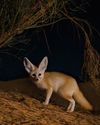FADING queen
BBC Wildlife
|October 2021
Far away in French Polynesia, a little songbird is clinging on to survival. Can the Fatu Hiva monarch beat the odds?

Echoing across a valley on the island of Fatu Hiva in the South Pacific Ocean is a sound heard nowhere else on Earth. Few have ventured into this narrow gorge of yellow blooming hibiscus and razor-leaved pandanus, for the only pathways are those forged by wild pigs. Anyone foolhardy enough to follow these trails must come armed with a machete and a willingness to scramble over sharp, slippery boulders.
Scientist Caroline Blanvillain describes the unusual cry heard here as “So powerful you believe the dinosaurs are coming”. Others liken this peculiar noise to the squeals of a dying cat. It emanates not from some mythical creature but from an insectivorous songbird called the Fatu Hiva monarch. At the time of writing, there are precisely 17 individuals left, making this little bird one of the most endangered animals in the world.
Fatu Hiva is the most southerly of the Marquesas Islands, an archipelago in north-eastern French Polynesia. There is no airstrip on Fatu Hiva and it can only be reached by boat. When drawn on a map, it is often depicted as a mere dot, and at only 15km long, it is indeed of miniature proportions. However, to visit Fatu Hiva is to witness the grandeur of a volcanic eruption frozen in time; a crest of mountains forms the spine of the island, from which ridges and ravines descend into the ocean. The island emerged from the sea so recently (a few million years is, of course, recent in geological timeframes) that its shores have not yet softened to sandy beaches; instead, black basalt columns rise like battlements, sheltering the rich green interior of the island from the vagaries of the waves.
Looks deceive
The Marquesan name for the Fatu Hiva monarch is ’
Denne historien er fra October 2021-utgaven av BBC Wildlife.
Abonner på Magzter GOLD for å få tilgang til tusenvis av kuraterte premiumhistorier og over 9000 magasiner og aviser.
Allerede abonnent? Logg på
FLERE HISTORIER FRA BBC Wildlife

BBC Wildlife
"I was terrified the elephant would ram us"
African elephant in Kenya
2 mins
January 2026

BBC Wildlife
ALL YOU EVER NEEDED TO KNOW ABOUT THE Fennec fox
THE FENNEC FOX IS THE SMALLEST fox in the world, with a body length that can be as little as 24cm.
3 mins
January 2026

BBC Wildlife
INTO THE PLASTISPHERE
A unique synthetic ecosystem is evolving in our oceans – welcome to the plastisphere
7 mins
January 2026

BBC Wildlife
“More than half of all animal life exists in a parasitic relationship, and all life lives in symbiosis”
Our survival depends on species evolving to live together - but some relationships take dark turns
7 mins
January 2026

BBC Wildlife
Are animals able to dream?
SLEEP IS A MYSTERIOUS THING. FOR A long time, we weren't sure why we do it.
1 mins
January 2026

BBC Wildlife
Does a cuckoo know it's a cuckoo?
ABSURD LITTLE BIRDS ACROSS THE world lay their eggs in the nests of other species, leaving the hapless parents to raise a changeling at the expense of their own offspring.
2 mins
January 2026

BBC Wildlife
Orcas killing young sharks
Juvenile great whites are easy prey for orca pod
1 mins
January 2026

BBC Wildlife
Ocean goes on tour
Acclaimed film touring the UK, backed by live orchestra and choir
1 min
January 2026

BBC Wildlife
Feisty bats hunt like lions
Winged mammals use a 'hang and wait' strategy to take down large prey
1 mins
January 2026

BBC Wildlife
SNAP-CHAT
Richard Birchett on magical merlins, wily coyotes and charging deer
2 mins
January 2026
Translate
Change font size

